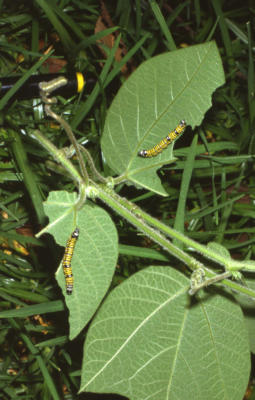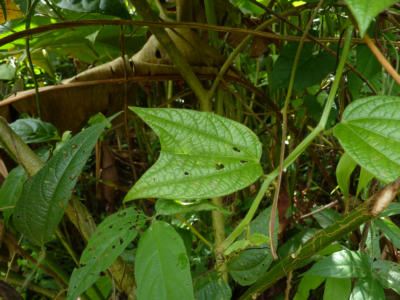Passiflora costaricensis
P. costaricensis is uncommon in second growth habitats at La Selva, but several plants may consistently be found in the artificially maintained successional plots. The unusual leaf shape, the fuzzy hairs of the leaf blade,the triangular stems and the lack of foliar or petiolar nectaries are distinctive. A member of a similarly distinctive Passiflora section: Xerogona, subgenus Decaloba. Range: eastern Mexico to Ecuador; in wet forests below 1800 meters elevation.
P. costaricensis foliage is strongly cyanogenic when crushed ranging from 1 to 20 μM HCN per gram fresh plant tissue. The spindle-shaped fruits are similarly strong and should be considered very poisonous. P. costaricensis probably contains the complex diglycoside cyclopentyl cyanogenic glycoside Passicapsin. According to Spencer 1988, two close relatives of P. costaricensis, P. capsularis and P. conzattiana, contain that compound. In the survey by Smiley and Wisdom (1985) P. costaricensis was the only Passiflora that lacked alkaloids in the foliage. Tannins were not detected, either. See Appendix 2 for cyanogenesis measurements: charts A18, A19 and A20.
I have observed H. cydno laying eggs on the tendril tips of P. costaricensis at La Selva.
Flea beetles are not commonly seen on this plant, but I have observed the generalist Blue Flea Beetle (Monomacra violacea), Yellow-legged Flea Beetle Parchicola DF2 and the Red-black Flea Beetle Monomacra chontalensis. This Passiflora is also fed upon by a colorful orange and black moth in the family Dioptidae, Josia frigida. This Josia appears to be a specialist on P. costaricensis and related species of Passiflora in section Xerogona. Josia larvae are spineless caterpillars ringed with one light blue band and three yellow bands for each abdominal segment. Interestingly, a species of old-leaf-feeding Heliconiini, Euides aliphera, has the same color pattern except for there being 2 yellow bands per segment (see photos below). This butterfly larva has a full set of spines, however, typical of Heliconiini. At La Selva I have found E. aliphera on P. costaricensis and the equally fuzzy, equally cyanogenic P. menispermifolia. A likely case of caterpillar mimicry?
Note the flea beetle chewing damage to the leaf in this picture.
P. costaricensis flower.

P. costaricensis is host to another specialist herbivore, a Dioptidae moth named Josia frigida. Will it release cyanide when feeding?
Close up flower androgynophore.
